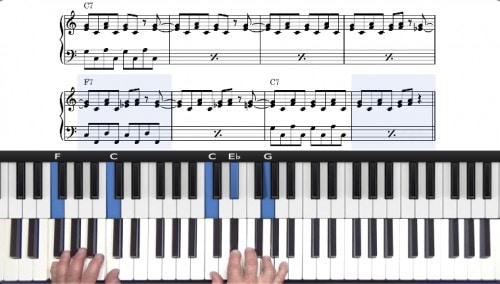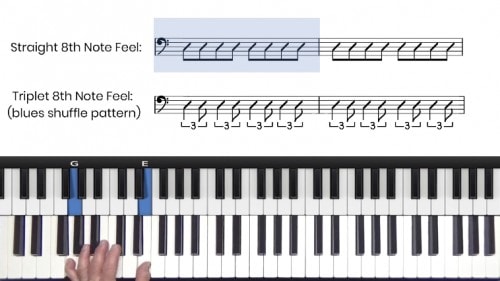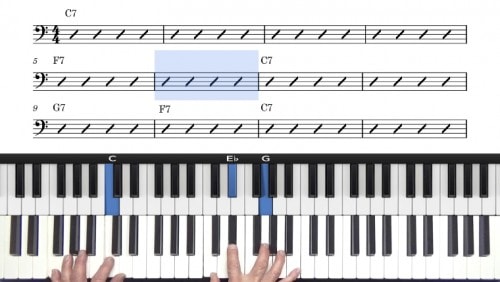How To Play Funk Piano
In this lesson we are going to talk about Funk and how it relates to the piano.
Funk is a hard thing to define but it’s fair to say that if you are playing piano with a rhythm section in New Orleans, at some point you will be playing Funk.
So What Is Funk?
In the earlier lessons we explored how we can break up the 4 beats of a bar, placing accents on the weak beats, and introducing dissonance in our chord voicings to make them sound ‘greasy’ and ‘nasty’.
Funk in a New Orleans context is something that has been going on for 100 years. In the accepted meaning of the word we are going to look at music that came out of New Orleans in the 1960s and 1970s.
The piano players that are associated with that generation and that era are Huey ‘Piano’ Smith, Allen Toussaint, Mac Rebennack, and to a degree James Booker.
Huey ‘Piano’ Smith
Huey Smith had a band called ‘The Clowns’. His style of playing was perhaps not what you would associate with the word Funk, but it was Funk in New Orleans.
In Jon’s examples we can see that the bass lines Huey Smith used were rooted in the tuba bass lines that we explored earlier in this course. The rhythms are played slightly slurred and there is an interplay between the left hand and the right hand which gives the music a certain swagger.
Huey Smith was a big influence on the piano players that came after him such as Mac Rebennack – also known as Dr John – and Allen Toussaint.
A Repeating Riff Or Motif
A lot of Funk records would revolve around a repeating riff or motif. A good example of this is tune “Sissy Strut” which was produced by Alen Toussaint. These ‘slabs of music’ contained an identifiable hook which the piano would weave around.
Hand Independence
Funk in the New Orleans context is maximising the elements that we covered earlier in this course; the syncopation and the dissonance. This requires that we develop independence between our right hand and our left hand.
Lesson Downloads
-
Funk Rhythms & Grooves File Type: pdf
-
Huey Smith Funk Groove File Type: pdf
-
Classified James Booker File Type: pdf
-
Huey Smith Style Funk – Audio File Type: mp3
-
Huey Smith Style Funk – Midi File Type: midi
Practice Tips
-
Check out the discography of Huey ‘Piano’ Smith, Allen Toussaint, Mac Rebennack, and James Booker to immerse yourself in the style New Orleans Funk music.
-
Many Funk records would revolve around a repeating riff or motif which the piano would weave around. Try to pick out some of these 'hooks' from recordings.
-
Practice octave bass patterns to create stronger bass lines and also fragment the octaves in the left hand to create more interesting rhythmic patterns.
-
The left hand is very important because it is playing the role of the bass drum and the snare drum in a rhythm section.
-
Remember that the piano is a percussive instrument and focus on independence between the hands just as a drummer would with the drum sticks.
-
New Orleans Funk incorporates rhythmic elements that we covered earlier in this course such as the 'Big 4' and the bass line patterns from the Rhumba and Habanera.
-
Practice Jon's left hand technique of emulating a press roll on a snare drum. This can be used to add more rhythmic interest into the left hand.










So fun!
This lesson kept me singing what one of our jazz teachers taught us:
“bucket-a-gum”
Say it over and over, you’ll see what I mean – it’s the rhythm Jon’s playing over and over in the press rolls part!
I kind of want to learn everything he’s playing!!!!
Hey Megan 👋🏻
Thanks for sharing “bucket-a-gum” – words and phrases like this can be awesome tools for internalising rhythms.
Yes those press rolls are so cool… I need to practice those myself. It adds so much depth to the groove!
And I agree…. there is a lot to be absorbed in this lesson 🤩
Cheers!
Hayden
Why doesnt he walk us through any exercises. I took the masterclass and it has this same problem. Telling me why it sounds good is cool and all but I just want learn how to do it.
Hi Yousif,
Check out this seminar where Jon breaks down the steps for playing a funk groove:
pianogroove.com/live-seminars/jon-cleary-blues-workshop-2/
See the chapters about funk and that should help to answer your funk related questions.
This course is an overview of New Orleans Piano and so please refer to the seminar above for specific exercises to build a funk groove.
Let me know if I can help further here.
Cheers,
Hayden